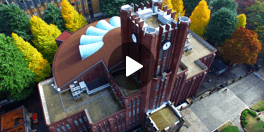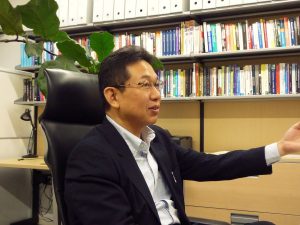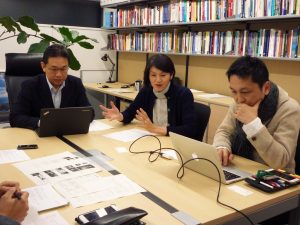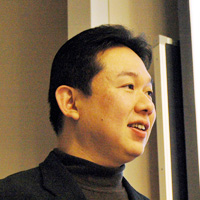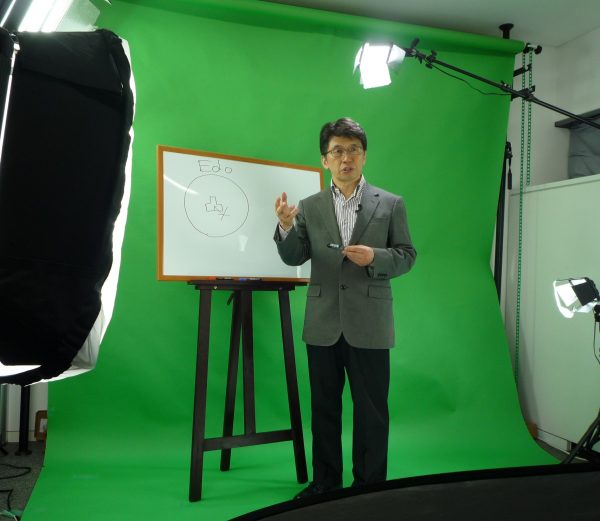
November 25, 2016
学環とMOOC(1)MOOCs and the III Part 1
いま、MOOCが注目を浴びています。MOOCとは、Massive Open Online Courseの略で、多くの人がオンライン上で無料で学習できる講座を指します。これまで東京大学では、藤原帰一教授「Conditions of War and Peace」(2014年度)、隈研吾教授・小渕祐介准教授「Four Facets of Contemporary Japanese Architecture」(2016年度)など9講座ほどが公開されてきました(詳しい一覧は、こちら)。
情報学環は、これらの東大MOOC事業において、主にコースの「制作・運用」を担当しています。今回、山内祐平教授、一色裕里特任助教、荒優特任助教に、東大でのMOOCの現状やその将来についてお話をうかがいました。
東京大学とMOOC
東京大学では、大学総合教育研究センターがMOOCの企画と対外交渉を行い、情報学環が実際のコース制作・運用を担当しています。
東京大学が活用しているMOOCのプラットフォームは主に2つあり、一つがCoursera、もう一つがedXです。それぞれ登録者数は2,100万人、725万人と大規模で、これらのプラットフォームで講座を開設することは、東京大学の世界発信にとって大きなメリットとなっています。
これまで、東大のMOOC講座は、全コース累計登録者が326,068名、累計修了者が15,572名です(CourseraとedXの合算、2016年10月時点)。山内教授によれば、この「スケールの大きさ」にMOOCの魅力があるといいます。「東大の全学生数が28,000人、全留学生数が3,000人です。つまり、この累計登録者数は東大の全学生の約10倍、累計修了者数も東大の全留学生数の約5倍ということになります。しかも、ほぼ世界中の国々(180ヶ国以上)の人が受講しています。これはいままでにはない規模の学習環境です」。
Visualizing Postwar Tokyoの配信
2014年にはedXで、情報学環の吉見俊哉教授のVisualizing Postwar Tokyo(Part 1、 Part 2)も開講されました。同講座は、東京大学がハーバード大学、マサチューセッツ工科大学と連携し、初めて大学を横断して提供したオンライン講座となりました。この講義の登録者は、137ヶ国から約13,000人にのぼり(Part 1, 2の合計)、アンケート結果からコースの満足度も非常に高かったそうです。
「コースを受講して、日本への考えが変わりましたか?」という質問に対し、ある受講者はこう回答しています。「特に戦後から今に至るまでの日本の文化と東京について多くのことを学んだ。これまで日本社会の社会的な複雑性について認識がなく、日本からの視点は非常にありがたかった」。日本をよく知らなかった世界の学習者に対し、情報学環から魅力的な講座を発信できていることが分かります。
MOOCの次へ
2013年度に始まった東京大学のMOOCは、Visualizing Postwar Tokyoなど、これまで多くの講義が開講されてきました。MOOC事業はいま、こうして蓄積してきたコンテンツをどう活用していくかにフェーズが移行しています。オンライン上の映像学習だけでは、必ずしも十分ではない側面が分かってきたのです。
そこで、最近、情報学環では新たに「反転学習」の開発も行っています。反転学習とは、オンライン学習と対面学習を組み合わせる、新しい学習のかたちです。次回(第2回)は、「反転学習」がどのように設計されているのかについて伺ってみたいと思います。
記事:松山秀明(特任助教)
取材:潘夢斐(博士課程)、岡田美保(学環長秘書)、松山秀明
Recently, much attention has been given to MOOCs – massive open online courses, in which large numbers of people are able to learn online free of charge. A number of such courses have already been conducted by the University of Tokyo, including “Conditions of War and Peace” (taught by Prof. Kiichi Fujiwara in 2014) and “Four Facets of Contemporary Japanese Architecture” (taught by Prof. Kengo Kuma and Assoc. Prof. Yusuke Obuchi in 2016). (A full list of past courses can be found here.)
The III has played a key role in the University of Tokyo MOOC program, especially in the areas of production and management. On this occasion, we asked Prof. Yuhei Yamauchi, Assist. Prof. Yuri Isshiki and Assist. Prof. Yu Ara to talk about the present and future of MOOCs at the University of Tokyo.
The University of Tokyo and MOOCs
The Center for Research and Development of Higher Education laid plans and conducted external negotiations for the University of Tokyo MOOC program, while the Interfaculty Initiative in Information took charge of the actual course production and management.
The University of Tokyo has distributed courses mainly through two MOOC providers: Cousera and edX. Use of these platforms offers a major advantage to the University of Tokyo’s global outreach efforts, thanks to their very large number of registered users (21,000,000 and 7,250,000 respectively)
The combined total of users registered to date for courses offered through the two providers by the University of Tokyo is 326,068, and the number of those who have completed courses is 15,572. According to Prof. Yamauchi, part of the appeal of MOOCs is their huge scale: “The total number of students at the University of Tokyo is approximately 28,000, of whom about 3,000 are international students. In other words, the number of people taking MOOCs is about ten times greater than the number of students, and the number of people completing MOOCs is roughly five times greater than the number of international students. Furthermore, people from almost every country (more than 180 countries) in the world are taking MOOCs provided by the University of Tokyo. The size of this learning environment is unprecedented.”
“Visualizing Postwar Tokyo”
In 2014, a course called “Visualizing Postwar Tokyo” taught by Prof. Shunya Yoshimi of the III was distributed through edX. This course was organized jointly by the University of Tokyo, Harvard University, and Massachusetts Institute of Technology, making it the first online course conducted cooperatively by multiple universities. 13,000 people from 137 countries registered for it, and questionnaire results indicate a very high level of user satisfaction.
In response to the question “Did your view of Japan change as a result of taking the course?” one person replied as follows: “I learned a lot, especially about Japanese culture and Tokyo from the postwar period to the present. Previously I had not appreciated the social complexity of Japanese society, and I was grateful for the perspective from Japan..” The III was clearly able to provide a course appealing to learners around the world with little existing knowledge about Japan.
The Future of MOOCs
Since 2013, the University of Tokyo has produced a large number of MOOCs, including “Visualizing Postwar Tokyo.” The task now is examine ways to utilize the contents accumulated so far. There is a growing realization that simply providing online videos of lectures is not necessarily sufficient.
One of the ways in which the III seeks to address this is through the development of so-called “flipped learning.” This is a new style of learning that combines elements of online learning with face-to-face learning. The next article will describe how “flipped learning” has been designed and implemented at the III.
The article was written by Hideaki Matsuyama (Assistant Professor).
Material for this article was gathered by Pan Mengfei (PhD student), Miho Okada (Secretary to the Dean of the III), and Hideaki Matsuyama.
主担当教員Associated Faculty Members
教授
山内 祐平
- 文化・人間情報学コース
- アジア情報社会コース
Professor
YAMAUCHI, Yuhei
- Cultural and human information studies course
- ITASIA program
